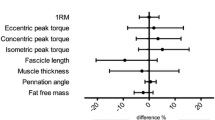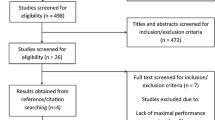Abstract
Purpose
We examined the possibility that wearing a below-knee compression garment (CG) reduces fatigue-induced strength loss and joint position sense (JPS) errors in healthy adults.
Methods
Subjects (n = 24, age = 25.5 ± 4 years) were allocated to either one of the treatment groups that performed 100 maximal isokinetic eccentric contractions at 30°−1 with the right-dominant knee extensors: (1) with (EXPCG) or (2) without CG (EXP) or to (3) a control group (CONCG: CG, no exercise). Changes in JPS errors, and maximal voluntary isometric contraction (MVIC) torque were measured immediately post-, 24 h post-, and 1 week post-intervention in each leg. All testing was done without the CG.
Results
CG afforded no protection against JPS errors. Mixed analysis of variance (ANOVA) revealed that absolute JPS errors increased post-intervention in EXPCG and EXP not only in the right-exercised (52%, p = 0.013; 57%, p = 0.007, respectively) but also in the left non-exercised (55%, p = 0.001; 58%, p = 0.040, respectively) leg. Subjects tended to underestimate the target position more in the flexed vs. extended knee positions (75–61°: − 4.6 ± 3.6°, 60–50°: − 4.2 ± 4.3°, 50–25°: − 2.9 ± 4.2°), irrespective of group and time. Moreover, MVIC decreased in EXP but not in EXPCG and CONCG at immediately post-intervention (p = 0.026, d = 0.52) and 24 h post-intervention (p = 0.013, d = 0.45) compared to baseline.
Conclusion
Altogether, a below-knee CG reduced fatigue-induced strength loss at 80° knee joint position but not JPS errors in healthy younger adults.





Similar content being viewed by others
Abbreviations
- ANOVA:
-
Analysis of variance
- CG:
-
Compression garment
- CONCG:
-
Control group, receiving CG
- EXPCG:
-
Treatment group #1, performing isokinetic training with below-knee CG
- EXP:
-
Treatment group #2, performing isokinetic training without below-knee CG
- JPS:
-
Joint position sense
- M:
-
Peak torque
- MVIC:
-
Maximal voluntary isometric contraction
- MVIC60 :
-
MVIC test trials at 60°
- MVIC80 :
-
MVIC test trials at 80°
- ROM:
-
Range of motion
- SD:
-
Standard deviation
References
Adam A, De Luca CJ, Erim Z (1998) Hand dominance and motor unit firing behavior. J Neurophysiol 80:1373–1382. https://doi.org/10.1152/jn.1998.80.3.1373
Alimi YS, Barthelemy P, Juhan C (1994) Venous pump of the calf: a study of venous and muscular pressures. J Vascu Surg 20:728–735. https://doi.org/10.1016/s0741-5214(94)70160-1
Arora S, Budden S, Byrne JM, Behm DG (2015) Effect of unilateral knee extensor fatigue on force and balance of the contralateral limb. Eur J Appl Physiol 115:2177–2187. https://doi.org/10.1007/s00421-015-3198-5
Brown SJ, Child RB, Day SH, Donnelly AE (1997) Indices of skeletal muscle damage and connective tissue breakdown following eccentric muscle contractions. Eur J Appl Physiol Occup Physiol 75:369–374. https://doi.org/10.1007/s004210050174
Busko K, Gorski M, Nikolaidis PT, Mazur-Rozycka J, Lach P, Staniak Z, Gajewski J (2018) Leg strength and power in Polish striker soccer players. Acta Bioeng Biomech 20:109–116
Cadore EL, Gonzalez-Izal M, Grazioli R, Setuain I, Pinto RS, Izquierdo M (2018) Effects of concentric and eccentric strength training on fatigue induced by concentric and eccentric exercise. Int J Sports Physiol Perform. https://doi.org/10.1123/ijspp.2018-0254
Collins DF, Prochazka A (1996) Movement illusions evoked by ensemble cutaneous input from the dorsum of the human hand. J Physiol 496(Pt 3):857–871
Faul F, Erdfelder E, Lang AG, Buchner A (2007) G*Power 3: a flexible statistical power analysis program for the social, behavioral, and biomedical sciences. Behav Res Methods 39:175–191
Friden T, Roberts D, Ageberg E, Walden M, Zatterstrom R (2001) Review of knee proprioception and the relation to extremity function after an anterior cruciate ligament rupture. J Orthop Sports Phys Ther 31:567–576. https://doi.org/10.2519/jospt.2001.31.10.567
Fugl-Meyer AR, Eriksson A, Sjostrom M, Soderstrom G (1982) Is muscle structure influenced by genetical or functional factors? A study of three forearm muscles. Acta Physiol Scand 114:277–281. https://doi.org/10.1111/j.1748-1716.1982.tb06983.x
Galamb K, Szilagyi B, Magyar OM, Hortobagyi T, Nagatomi R, Vaczi M, Negyesi J (2018) Effects of side-dominance on knee joint proprioceptive target-matching asymmetries. Physiol Int 105:257–265. https://doi.org/10.1556/2060.105.2018.3.22
Ghai S, Driller MW, Masters RSW (2018) The influence of below-knee compression garments on knee-joint proprioception. Gait Post 60:258–261. https://doi.org/10.1016/j.gaitpost.2016.08.008
Guette M, Gondin J, Martin A (2005) Time-of-day effect on the torque and neuromuscular properties of dominant and non-dominant quadriceps femoris. Chronobiol Int 22:541–558. https://doi.org/10.1081/CBI-200062407
Halperin I, Copithorne D, Behm DG (2014) Unilateral isometric muscle fatigue decreases force production and activation of contralateral knee extensors but not elbow flexors. Appl Physiol Nutr Metab 39:1338–1344. https://doi.org/10.1139/apnm-2014-0109
Hortobagyi T, Hill JP, Houmard JA, Fraser DD, Lambert NJ, Israel RG (1996) Adaptive responses to muscle lengthening and shortening in humans. J Appl Physiol 80:765–772
Ibegbuna V, Delis KT, Nicolaides AN, Aina O (2003) Effect of elastic compression stockings on venous hemodynamics during walking. J Vasc Surg 37:420–425. https://doi.org/10.1067/mva.2003.104
Kawamoto JE, Aboodarda SJ, Behm DG (2014) Effect of differing intensities of fatiguing dynamic contractions on contralateral homologous muscle performance. J Sports Sci Med 13:836–845
Lattanzio PJ, Petrella RJ, Sproule JR, Fowler PJ (1997) Effects of fatigue on knee proprioception. Clin J Sport Med 7:22–27
Lien N, Steel KA, Graham K, Penkala S, Quinn J, Dogramaci S, Moresi M (2014) What is the effect of compression garments on a novel kick accuracy task? Int J Sports Sci Coa 9:357–365. https://doi.org/10.1260/1747-9541.9.2.357
Marini F, Ferrantino M, Zenzeri J (2018) Proprioceptive identification of joint position versus kinaesthetic movement reproduction. Hum Mov Sci 62:1–13. https://doi.org/10.1016/j.humov.2018.08.006
Marks R, Quinney HA (1993) Effect of fatiguing maximal isokinetic quadriceps contractions on ability to estimate knee-position. Percept Mot Skills 77:1195–1202. https://doi.org/10.2466/pms.1993.77.3f.1195
Martin PG, Rattey J (2007) Central fatigue explains sex differences in muscle fatigue and contralateral cross-over effects of maximal contractions. Pflugers Arch 454:957–969. https://doi.org/10.1007/s00424-007-0243-1
Maton B, Thiney G, Dang S, Tra S, Bassez S, Wicart P, Ouchene A (2006) Human muscle fatigue and elastic compressive stockings. Eur J Appl Physiol 97:432–442. https://doi.org/10.1007/s00421-006-0187-8
Miura K, Ishibashi Y, Tsuda E, Okamura Y, Otsuka H, Toh S (2004) The effect of local and general fatigue on knee proprioception. Arthrosc J Arthrosc Related Surg Off Publ Arthrosc Assoc North Am Int Arthrosc Assoc 20:414–418. https://doi.org/10.1016/j.arthro.2004.01.007
Miyamoto N, Hirata K, Mitsukawa N, Yanai T, Kawakami Y (2011) Effect of pressure intensity of graduated elastic compression stocking on muscle fatigue following calf-raise exercise. J Electromyogr Kinesiol 21:249–254. https://doi.org/10.1016/j.jelekin.2010.08.006
Molinari F, Knaflitz M, Bonato P, Actis MV (2006) Electrical manifestations of muscle fatigue during concentric and eccentric isokinetic knee flexion-extension movements Ieee T. Bio Med Eng 53:1309–1316. https://doi.org/10.1109/Tbme.2006.873680
Mothes H, Leukel C, Seelig H, Fuchs R (2017) Do placebo expectations influence perceived exertion during physical exercise? PLoS ONE 12:e0180434. https://doi.org/10.1371/journal.pone.0180434
Negyesi J, Mobark A, Zhang LY, Hortobagyi T, Nagatomi R (2018) An above-knee compression garment does not improve passive knee joint position sense in healthy adults. PLoS ONE 13:e0203288. https://doi.org/10.1371/journal.pone.0203288
Oldfield RC (1971) The assessment and analysis of handedness: the Edinburgh inventory. Neuropsychologia 9:97–113
Paillard T, Chaubet V, Maitre J, Dumitrescu M, Borel L (2010) Disturbance of contralateral unipedal postural control after stimulated and voluntary contractions of the ipsilateral limb. Neurosci Res 68:301–306. https://doi.org/10.1016/j.neures.2010.08.004
Peat JK, Barton B, Elliott EJ (2008) Statistics workbook for evidence-based healthcare. Blackwell, Malden, Mass
Raju S, Fredericks R, Lishman P, Neglen P, Morano J (1993) Observations on the calf venous pump mechanism: determinants of postexercise pressure. J Vasc Surg 17:459–469
Ribeiro F, Mota J, Oliveira J (2007) Effect of exercise-induced fatigue on position sense of the knee in the elderly. Eur J Appl Physiol 99:379–385. https://doi.org/10.1007/s00421-006-0357-8
Romero-Franco N, Jimenez-Reyes P (2017) Effects of warm-up and fatigue on knee joint position sense and jump performance. J Mot Behav 49:117–122. https://doi.org/10.1080/00222895.2016.1152222
Rossetti Y, Meckler C, Prablanc C (1994) Is there an optimal arm posture—deterioration of finger localization precision and comfort sensation in extreme arm-joint postures experimental. Brain Res 99:131–136
Tanaka M, McDonagh MJ, Davies CT (1984) A comparison of the mechanical properties of the first dorsal interosseous in the dominant and non-dominant hand. Eur J Appl Physiol Occup Physiol 53:17–20. https://doi.org/10.1007/bf00964683
Tiggelen DV, Coorevits P, Witvrouw E (2008a) The effects of a neoprene knee sleeve on subjects with a poor versus good joint position sense subjected to an isokinetic fatigue protocol. Clin J Sport Med 18:259–265. https://doi.org/10.1097/JSM.0b013e31816d78c1
Vaczi M, Tihanyi J, Hortobagyi T, Racz L, Csende Z, Costa A, Pucsok J (2011) Mechanical, biochemical, and electromyographic responses to short-term eccentric-concentric knee extensor training in humans. J Strength Cond Res 25:922–932. https://doi.org/10.1519/JSC.0b013e3181c1fa47
Vafadar AK, Cote JN, Archambault PS (2015) Sex differences in the shoulder joint position sense acuity: a cross-sectional study. BMC Musculosk Disord. https://doi.org/10.1186/s12891-015-0731-y
van Melick N, Meddeler BM, Hoogeboom TJ, Nijhuis-van der Sanden MWG, van Cingel REH (2017) How to determine leg dominance: The agreement between self-reported and observed performance in healthy adults. PLoS ONE 12:e0189876. https://doi.org/10.1371/journal.pone.0189876
Van Tiggelen D, Coorevits P, Witvrouw E (2008b) The use of a neoprene knee sleeve to compensate the deficit in knee joint position sense caused by muscle fatigue. Scand J Med Sci Sports 18:62–66. https://doi.org/10.1111/j.1600-0838.2007.00649.x
Vangsgaard S, Norgaard LT, Flaskager BK, Sogaard K, Taylor JL, Madeleine P (2013) Eccentric exercise inhibits the H reflex in the middle part of the trapezius muscle. Eur J Appl Physiol 113:77–87. https://doi.org/10.1007/s00421-012-2412-y
Zhang LY, Négyesi J, Okuyama T, Tanaka M, Hortobágyi T, Nagatomi R (2019) Position of compression garment around the knee affects healthy adults’ knee joint position sense acuity. Hum Mov Sci 67:102519. https://doi.org/10.1016/j.humov.2019.102519
Zijdewind C, Bosch W, Goessens L, Kandou TW, Kernell D (1990) Electromyogram and force during stimulated fatigue tests of muscles in dominant and non-dominant hands. Eur J Appl Physiol Occup Physiol 60:127–132. https://doi.org/10.1007/bf00846032
Funding
The authors declare that the research was conducted in the absence of any commercial or financial relationships that could be construed as a potential conflict of interest.
Author information
Authors and Affiliations
Contributions
JN and RN designed the research. JN, LYZ and RN performed the research. JN analyzed the results. JN directed the research. JN, TH and RN wrote the manuscript and all the authors have read and approved the final version.
Corresponding author
Ethics declarations
Conflict of interest
All authors declare that they do not have any conflict of interest.
Additional information
Communicated by Lori Ann Vallis.
Publisher's Note
Springer Nature remains neutral with regard to jurisdictional claims in published maps and institutional affiliations.
Electronic supplementary material
Below is the link to the electronic supplementary material.
421_2020_4507_MOESM1_ESM.xlsx
S1_Data_JPS. Supporting data for joint position sense errors in both the right exercised and the left non-exercised leg in each group, time point, and range of motion (XLSX 25 kb)
421_2020_4507_MOESM2_ESM.xlsx
S2_Data_MVIC. Supporting data for maximal voluntary isometric contraction torque in both the right exercised and the left non-exercised leg in each group and time point (XLSX 12 kb)
Rights and permissions
About this article
Cite this article
Négyesi, J., Zhang, L.Y., Jin, R.N. et al. A below-knee compression garment reduces fatigue-induced strength loss but not knee joint position sense errors. Eur J Appl Physiol 121, 219–229 (2021). https://doi.org/10.1007/s00421-020-04507-1
Received:
Accepted:
Published:
Issue Date:
DOI: https://doi.org/10.1007/s00421-020-04507-1




